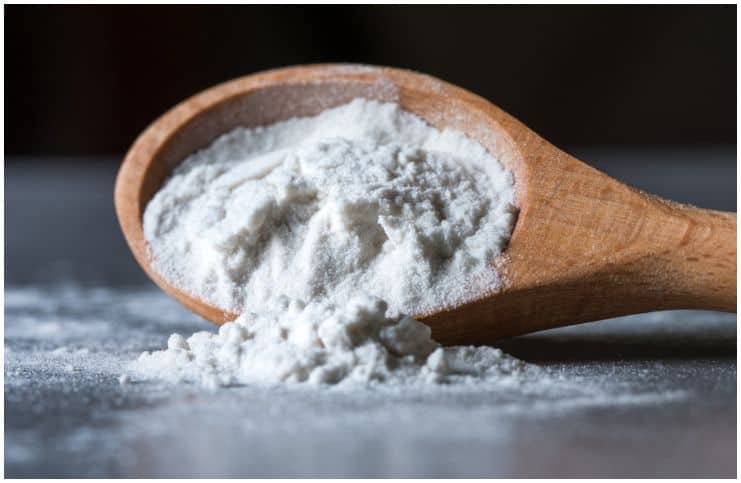Is monocalcium phosphate bad for you?
Monocalcium phosphate is a leavening acid commonly found in bread, cake, and other baked foods to improve texture.
It has good solubility in water, with medium hygroscopic properties.
It is obtained by the reaction of a calcium compound like calcium carbonate, calcium hydroxide, or calcium phosphate with phosphoric acid.
Chemical Formula
Ca(H2PO4)2
Is It Vegan?
Yes and no, depending on where phosphates are sourced.
It is recommended to check with the producer to find out exactly the source of MCP.
READ MORE: Disodium Guanylate (E627) In Food – Side Effects
Uses
MCP acts as a restorative to the mineral deficiency (calcium and phosphorous) in the diet of cattle.
It is also used in the food industry as a leavening agent, i.e., to cause baked goods to rise.
MCP is used in products like:
- malted milk powder;
- pancakes;
- curing agent for pectin;
- cereal flour;
- cake mixes;
- canned tomatoes;
- biscuits;
- canned potatoes;
- muffins;
- condiments;
- energy powders;
- doughnuts;
- cookies.
MCP can be used as an emulsifier and flavor enhancer in beverages.
Side Effects & Health Risks of Monocalcium Phosphate In Food
It is classified by the U.S. Food and Drug Administration as generally regarded as safe, however, some people experience bloating, excessive gas, diarrhea, constipation, stomach pain, or indigestion.
Allergic Reactions
MCP can also cause allergic reactions, such as:
- skin problems – itching, hives, swelling, and rashes;
- respiratory problems – rhinitis, asthma, and sinusitis;
- nervous disorders – insomnia, hyperactivity, and irritability;
- digestive disorders – colicky pains and diarrhea.
READ MORE: Dextrose vs Maltodextrin
Too Much Phosphorus (Hyperphosphatemia)
Phosphorus is a mineral that is part of every cell in your body.
It is the 2nd most abundant element in an animal’s body after calcium, with about 80 percent of phosphorus found in the teeth and bones.
Phosphorus is an essential component of the phospholipids that make up the cellular membrane.
The body uses phosphorus to:
- use B-complex vitamins;
- form strong teeth and bones;
- produce hormones;
- maintain a normal pH balance;
- move muscles;
- get oxygen to tissues;
- develop organs and connective tissues;
- change fat, protein, and carbohydrate into energy;
- create energy.
Phosphorus can also be considered a brain and nerve tonic, that is crucial for the optimal health of the nervous system.
Additionally, phosphorus works with the body in storing energy and helps the kidneys filter out waste.
However, an intake of too much phosphorus can lead to certain health problems, especially in people without kidney disease. One study has found an association between heart disease and dietary phosphorus. Another study has linked higher phosphorus levels in the blood to increased cardiovascular risk.
Additional studies have established that serum phosphorus concentrations above 4 mg/dL were strongly associated with a 100 percent increased risk of developing end-stage renal disease and cardiovascular disease in people free of renal disease at study inception.
Too much phosphate can also cause calcification (hardening) of organs and diarrhea, as well as it can interfere with the body’s capacity to use calcium, magnesium, iron, and zinc.
READ MORE: Robitussin vs Dayquil
Too Much Calcium (Hypercalcemia)
Calcium is a chemical element that is essential for living organisms. For example, it plays an important regulatory role in the maintenance of normal body weight.
For adults, too little calcium can increase your risk of developing osteoporosis, a type of bone disease. Calcium also affects the smooth muscle which surrounds blood vessels, causing it to relax.
Moreover, calcium can reduce a wide variety of premenstrual syndrome symptoms by as much as 50 percent, according to a study that was issued by the American Journal of Obstetrics and Gynecology.
Other functions of calcium in the body include:
- triggers the formation of blood clots;
- aids in regulating the heartbeat;
- stimulates hormone and enzyme secretion;
- regulates fluid balance by controlling the flow of water into and out of the cells;
- lowers blood pressure;
- helps muscle contraction and expansion;
- conducts nerve impulses that transmit messages through the CNS (central nervous system).
A calcium deficiency can result in the following symptoms:
- heart problems involving heart rhythms and blood pressure;
- brittle, weak bones;
- delays in children’s development and growth;
- fatigue;
- bone fractures;
- weakness;
- problems with proper blood clotting;
- osteoporosis.
Too much calcium over time can be damaging to the brain as well as it can cause an irregular heartbeat.
In some cases, too much calcium can cause deposits of calcium in your blood. Also, extra calcium may increase your risk of kidney stones.
Other health risks of too much calcium intake include:
- interferes with vitamin K synthesis;
- gallbladder stones;
- blocks manganese uptake;
- increased risk for gout;
- calcium deposits in the joints, that eventually promote bone spurs and arthritis;
- increases acidity in the body;
- prevents cellular regeneration;
- increases cancer risk;
- blocks certain enzyme reactions;
- reduces the effectiveness of thyroid drugs;
- causes a loss of zinc from the body;
- decreases iron absorption, which can lead to iron anemia deficiency;
- interferes with the absorption of magnesium.
Final Words
In the present day, it is simply not enough to buy healthy, high-quality food, but it is also important that your food be free of harmful additives – substances that do not occur naturally in food.
READ THIS NEXT: Phosphoric Acid (E338) – Side Effects
References https://www.ncbi.nlm.nih.gov/pubmed/15348169 https://www.researchgate.net/publication/279530880 https://link.springer.com/article/10.1023%2FA%3A1020367900773




